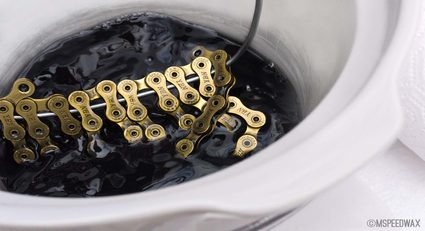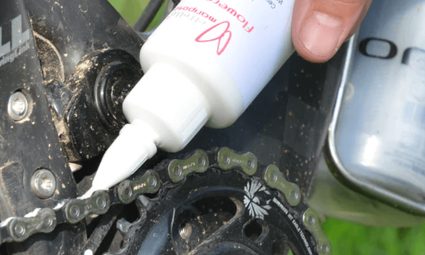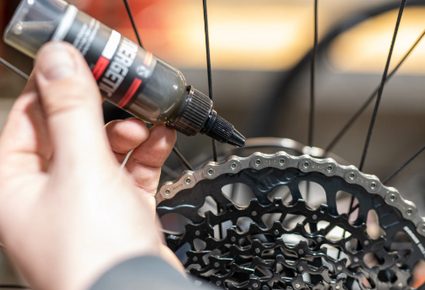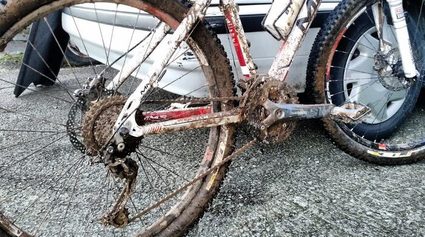Bicycle Lubricant Cost-to-Run Calculator
Oil, wax, wet, dry... there are multiple options for lubricating your bike's drivetrain, and it's important to choose the best one for you — OR IS IT? With this lubricant cost-to-run calculator, you can see exactly what's the right lubricant for you and the true difference between the best and the worst.
Will the expensive one pay for itself by keeping your drivetrain running for longer? What if you cycle off-road? Are cheap lubricants worth it? How many parts will you need to replace after 1,000 km? All of these questions can be answered with this simple calculator!
Lubricants are the best friends of your bike
Bikes are some of the simplest machines in the world: efficient, accessible, and very easy to use. But like any machine, it requires care and attention from time to time. How much and how often comes down to the amount of riding you do, where you ride, and how important it is for you that your bike always performs at its best.
One of the most important parts to maintain on your bike is the drivetrain. The chain, the cassette, and the chainrings are constantly moving under load, grinding metal against metal and exposed to the elements. That's why we lubricate our chains — a small coat of a slick lubricant will prevent your metal components from rubbing and wearing themselves down and keep all the dirt away.

So, a great lubricant should make our bike run smoother and more efficiently, prevent any contamination from the outside from sticking to our drivetrain — simply put, it will significantly extend the life of our chain, cassette, and chainrings. Great, but which lubricant will do that? That's where our calculator will help you!
Guide to using the cost-to-run calculator
In his quest to find the best lubricant, Adam Kerin created , a lubricant testing lab dedicated to helping us cyclists find the best lubricant for our needs. ZFC has quickly become the biggest and most reputable source of open data on lubricant performance. If you want more information on the testing methodology, we have a section at the bottom where we dive deeper into lubricant testing.
For now, let's focus on the calculator itself. Powered by years' worth of ZFC test data, this bicycle lubricant cost-to-run calculator gives you the most important data in an easily understandable way. Let's see how you can get the most out of it:
- Select the terrain in which you do most of your riding.
- Select the tier of components you use in your drive train or choose "Enter your own" and input the individual price of each component if you prefer.
- Choose a lubricant from the list to see the simulated results of using it in your selected terrain.
- Select the distance for which you want to calculate the cost. The longer the distance, the higher the cost will be due to more components wearing out.
- SUCCESS! You will now see the cost-to-run for your selection right below the input fields, with a breakdown of the cost by item to help you understand the numbers better.
The result shown by the calculator is the total expected cost after using a given lubricant for your selected distance. It adds up the cost of the lubricant and the cost of any components that are expected to get worn after said distance. Good lubricants tend to be more costly, and they represent an investment that will pay back after a few thousand kilometers as your components will last longer.
Real cost-to-run vs. average cost-to-run
The calculator can show two different types of cost-to-run: real or average. The average cost-to-run takes into account components that are partially worn. For example, if your cassette is worn 50% of the way, it will add half the cost of a cassette to your total cost-to-run. This makes it easier to compare lubricants, but in reality, components cannot be partially replaced.
For a more real-world cost, choose the "Real cost" option. This will count only components that are fully worn and, therefore, should have been replaced. This is more representative of the real cost-to-run of a lubricant, but makes it harder to compare between lubricants. For example, a lubricant that's worn your chain to 90% will not add a chain to the total cost-to-run, while if a lubricant has worn exactly one chain, it will count as replaced. If this small difference is present in more expensive components or for several of them, there could be an artificially high disparity in the cost-to-run despite both lubricants performing very similarly.
The results — summarized
Lubricants come in three main types: Immersion waxes, drip waxes, and oil-based. The short answer to what's best is that the results show that wax-based lubricants offer significantly better performance than oil-based lubes.
However, bicycle drivetrain lubrication is not an easy task. That's why it's not hard to find immersion waxes that perform worse than oil-based lubricants, nor to find drip wax lubricants that outperform oil and immersion wax lubricants, nor even to find oil-based lubricants that work so badly that you're better off using the factory grease used to package your chain (even though it's not meant to be used as a lubricant).
The long answer to what the best lubricant is is personal and complicated. This is especially true if we take into account that each type of lubricant requires a different type of preparation and care to work optimally. Let's now take a quick look at these differences.
Pros and cons of each type of lubricant
Each of the 3 types of lubricants mentioned above has its own set of benefits and inconveniences, and they all require slightly different preparation and care of your drivetrain.
💡 If you really want to make the best out of your drivetrain in terms of efficiency and longevity, we recommend the resources by industry experts such as Silca, ZFC, Ceramic Speed... and always follow the manufacturer's instructions to avoid running into issues.
Immersion Wax Lubricants

These are generally the best-performing lubricants, according to the tests. They typically come as solid wax that you need to melt in a slow cooker or similar temperature-controlled container.
To lubricate, you simply dip the chain in the melted wax, and after a few minutes of soaking and stirring, the chain is hung to dry. The main downsides of immersion waxing a chain is that it requires a thorough cleaning of the chain and other components before the first application. It also requires you to take the chain off to apply a fresh coat of lubricant. And, it generally requires a bigger upfront investment.
On the flip side, it carries some great benefits. First of all, the lubrication process gets rid of all the contaminants trapped in the chain from riding it, so you can forego cleaning your drivetrain. It also dries solid, so it picks up a minimal amount of dirt. It generally has the lowest friction and lowest wear rate of any lubricant.
Drip Wax Lubricants

These are liquid lubricants that dry solid. They are also wax-based as the immersion wax lubricants, but in this case, the wax is emulsified (typically with water), so they don't need to be heated up. They aim to bring the amazing performance of immersion waxing while requiring a care routine more akin to that of traditional oil-based lubricants.
Their main downsides are the need for thorough cleaning of the drivetrain (especially the chain) before the first use and the need for periodically cleaning your drivetrain. That's because they might not dry as solid as immersion waxing, and the re-lubricating process doesn't get rid of all the impurities picked up from the road.
In return, you get a performance that can rival the best immersion waxes in terms of longevity and a very simple process of re-lubrication. Simply put a drop of wax lubricant per link of your chain, pedal the chain backwards a couple of times, and leave it overnight so that the wax can dry and the carrier evaporates — done!
Oil-based lubricants

Oil-based lubricants are the most traditional lubricants. As a natural evolution from lubrication in other industries, these lubricants have an oil base with some additives mixed to help reduce friction and wear.
They tend to have the worst performance of any lubricant type, though there are exceptions. Their usage is by far the simplest: apply a drop of lubricant per chain link, spin the cranks backward, and remove the excess with a clean rag.
However, that simplicity is paid for with the maintenance required by these lubricants. Since they are oil-based, their wet nature attracts and clings to a lot of dust, mud, and debris found on the road. Dirty chains will wear out your drivetrain extremely fast, so it is imperative to frequently and thoroughly clean your chain (and other drivetrain components) to ensure adequate lifespan of your components.
Why are the good lubricants SO MUCH better than the bad ones?
The job of a lubricant might seem simple at first: reduce friction and wear between metal components. Even cooking oil should do that extremely well, right? Yes, in a clean laboratory, it would (kinda). But we ride our bikes outside where there's dirt, dust, and all kinds of contaminants that get flung by the wheels into our drivetrain. If these particles stick to our chain or cogs, it will create extra friction and greatly accelerate the wear rate of our precious components.
A good lubricant should prevent all this road dirt and debris from sticking to our chain and cogs, be able to get rid of them as we ride, and generally maintain the drivetrain as clean as possible for as long as possible.
If we look at the ZFC data, the lubrication part in a clean environment is easy. Almost all lubricants can significantly reduce the friction and wear on your components. But when contamination is introduced, that's when the wheat gets separated from the chaff. ZFC tests dry contaminants and wet contaminants to simulate dry, dusty offroading as well as muddy mountain biking (or cyclocross conditions). In these testing blocks, the worst lubes can see wear rates over ten times those of the top lubricants.
This clearly points to dirt and grit from the road being the primary cause of premature wear. In consequence, solid lubricants will generally outperform wet and oil-based lubricants. This insight also points to a key part of preventing premature wear of your components: cleaning your bike's drivetrain. They say, "A clean bike is a fast bike," but a clean bike is also a longer-lasting, cheaper-to-run bike.
Cleaning your drivetrain — a must for lasting drivetrains
The cleaning process depends on the type of lubricant that you use. While immersion waxing will clean the chain as part of the relubrication process, drip-wax lubricants and oil-based lubricants require active care and periodic cleaning of the chain, cassette, and chainrings for optimal performance.
If you are using a drip-wax lubricant, it is recommended to pour boiling water over it from time to time, or to directly submerge your chain in a pot of boiling water. This will melt the old wax and help flush it out together with all the contaminants that might have stuck to it.
For those using oil-based lubricants, the process is slightly more involved. It generally includes using bike-specific degreasers (please be kind to the planet and use the biodegradable kind), thoroughly scrubbing the old grease and dirt off your bike, and rinsing and re-lubing the chain before storage.

⚠️ Regardless of your method for lubricating and cleaning your drivetrain, remember that it is very important that you never store a bike with a water-wet chain as it will cause it to rust. Once you're done cleaning the chain, reapply your lubricant of choice or thoroughly dry it off before putting your bike away.
Data validity, accuracy, and additional insights
As you might imagine, gathering so much high-quality data requires making some choices and setting strict testing protocols. For those interested in all the details, ZFC has excellent information on their testing protocol and how they analyze their data.
However, very often in science, one has to compromise accuracy and repeatability for the sake of relatability, i.e., gathering data that represents what happens in the real world. This calculator is no different, and in this section, we will see what are the limitations of the results so that we can make the best use of the calculator:
Wear rate of components
The relative wear of components is very hard to measure, and it is affected by multiple factors like the shifting habits of the rider, the quality of the components, power output, preferred gear selection...
However, the wear of the cassette and the chainrings is driven by the wear on the chain, so we can approximate the former from the latter. For these calculations, we have set the relationships between wears so that one cassette will last for as long as 2 chains, and one set of chainrings will last for as long as six chains do. This is roughly in line with the experience most of you have had in your years of cycling.
💡 Pro-tip: Different combinations of cassettes and chains and chainrings will yield slightly different wear ratios. However, those ratios will be consistent from one lubricant to another, since the main mode of wear for your cogs is the slight misalignment of the chain rollers in between the teeth of the cogs.
Price of individual components and chosen price points
As with any product, there is no single price for an item. The price of your components will vary from day to day, from country to country, and even from store to store! With that said, we've done our best to create some orientative presets based on Shimano's groupsets. The "Expensive" price roughly matches that of Dura-Ace components, the "Midrange" option is in line with Ultegra level components, and the "Cheap(er)" would be similar to 105 components. The presets are only available for Australia (AUD), Europe (EUR), the United Kingdom (GBP), and the United States (USD).
🙋 While we understand that Shimano's 105 groupset is not cheap at all, it is comparatively cheaper than Dura-Ace or Sram Red eTap while also being a very popular option amongst hardcore cyclists.
If you're visiting from a country without presets (or if you want to input values for different components), you have the option to input custom costs for each component so that you can still get the most out of the calculator. To do so, simply select the "Enter your own pricing" options, and the fields will appear for you.
Calculator cost vs. Real-world cost
All of the factors above mean that the results you obtain in the calculator cannot be considered a highly accurate prediction of what it would cost you to run a given lubricant. But that's okay — this was never meant to be an economics calculator. As a cycling calculator, however, it is the best tool available for comparing different lubricants between them. Having this highly standardized and repeatable collection of data means that the relative difference between lubricants would hold true in your particular case.
This is the beauty and the value of this calculator; it can give you the confidence to make the best decision for yourself without having to test the lubricants for yourself. All you need to do is figure out your perfect balance of ease of use, performance, and, obviously, cost-to-run.